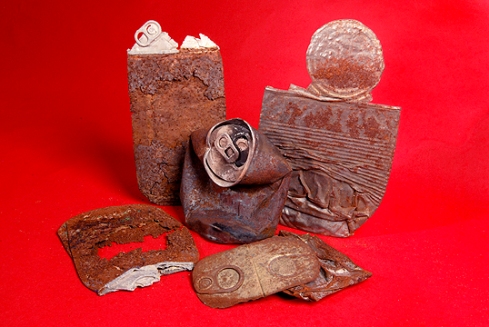You are currently browsing the daily archive for February 6, 2007.
Africa is, sadly, where the rest of the world dumps its garbage. Here is where all the unwanted things end up—those puffy neon-pink parachute jackets from the 80s, car batteries with only a year left out of the original 10, the sweepings off the floor of the tea factories, repackaged and sold cheaply. Did you ever wonder where the rest of the chickens go, as you stare at the supermarket rows of boneless, skinless breasts? You can buy them here in Africa, sold as cuisse (french for thigh), arriving frozen from Europe in 10 kilo boxes. They are skin-on and bone-in, almost half a chicken with a drumstick and wing still attached.
Here, you can buy cheap plastic toys. You can pay a lot for these at the fancy import stores, or buy them cheaply at the local market, but it makes no difference—the toy will be broken literally within half an hour of coming out of its package.
In one of the poorest nations on earth, where everything is stained with dust, the desert lies deep within. Garbage lies in piles along the streets. Driving along, people toss empty pop cans and juice cartons out of their windows. The wind helps move things along. Plastic bags whirl with a weird grace, twirl high in the air, land in your yard to add clutter and ugliness.
I am thinking about this as my husband collects garbage to photograph. He has always done this; his genius is to see the potential beauty in the most mundane or unlovely of objects. When asked, he will say that “it has as much form and texture as anything else, but you don’t look at it because it’s ‘trash.’” But the trash here is so…dirty, so used, so much more, well, trashy. I don’t want it in the house.
Photography is not well understood in Mauritania. People are suspicious. If you ask them why, you will hear one of several answers.
- Old people don’t like it because Islam prohibits images, which is why Islamic art is calligraphic and geometrical. (But, one replies, why does everyone have satellite TV then?)
- About 10 years ago some journalists came through and took pictures of what they called a slave market although it actually wasn’t, and tried to make it look like we still had slaves, when slavery was officially outlawed in the 1980s and no longer exists here.
- Journalists take pictures and make us look poor. They exploit us.
Amina and I discuss this over coffee. I argue that until Mauritanians get more comfortable with being photographed, tourism (which they desperately want) will never develop. Tourists take pictures; they want memories, souvenirs, I say. I tell of being with a visitor who wanted to take pictures of the herds of camels gathered for feeding; it was dusk and the sky was the palest of pinks, and the nomads and their tents were in the background, and we were driving along the Rue de Nouadhibou, which goes from Morocco to Senegal and is one of the main roads in the entire country. He simply wanted to capture this picturesque moment, unique in the annals of the modern world. But the people protested and wouldn’t allow even an innocent picture of some animals. She nods. Some people are like that, she comments.
I point out that Marche Capitale, the city’s main market, is colourful and interesting, with its swirling kaleidoscope of people shouting prices and brandishing goods in your face, young men in long white robes going “Psh! Psh!” to get your attention, piles of muluffas in lime, pink, midnight blue, yellow and orange tie-dye, all lying on the ground in loose folds of cloth, mounds of shoes, heaps of plastic barrettes and pony-tail holders, plastic bags of unmarked spices, etc. The market is right downtown and the streets that border it are filthy with refuse—piles of wet tea leaves, wandering goats, cardboard and plastic trash, perhaps the bones and offal from a recently-slaughtered animal.
Amina agrees that yes, the market is fine to photograph. “But I saw tourists at the market, and they took pictures of the trash,” she protests. “Naturally people were upset.”
I take a deep breath and point out that rather than get upset at the tourists, people might think of cleaning up the trash. Amina purses her lips in thought, then agrees. “But,” she says sadly, “they don’t think of that.”
They don’t; it’s true. We excuse Mauritanians and their trash by saying that of course, as nomads there was no recycling they had to just toss things, but everything was biodegradable. It doesn’t quite work anymore though. On the other hand, it’s not like Americans don’t ever litter. Until laws and fines were enacted, our highways were receptacles of junk, and I belong to one of those families who always comments in disgust at finding other people’s pop and beer cans in an otherwise pristine picnic spot.
This post is not going the direction I intended. I wanted to discuss concepts of found beauty, how we can look at the passage of time etched by sand and sun and rejoice not in youth and freshness but in age, how, as Adam Gropnik put it when discussing the mosaic mermaids at the bottom of the Ritz Hotel in Paris, “the line between art and kitsch is largely measured in ruin.” Or, to put it another way, “One man’s trash is another man’s treasure.” But thinking of garbage led my thoughts in another direction.
Here is the picture Donn took of 2 tin cans and one ancient Coke can—although given the aging properties of a desert, the word ancient here means “outside for about a month.”
And if sun and sand can do this to metal, imagine what they’re doing to my face!!








